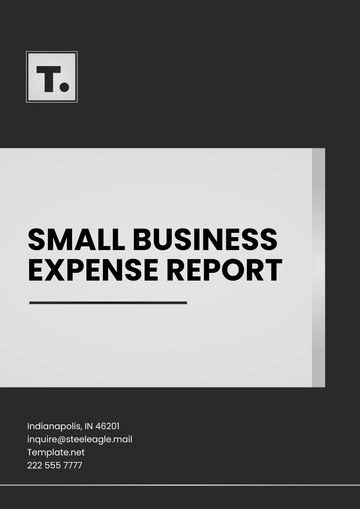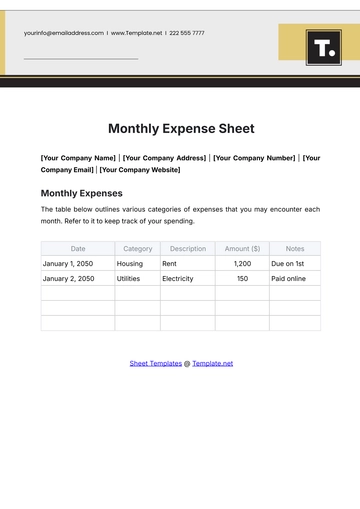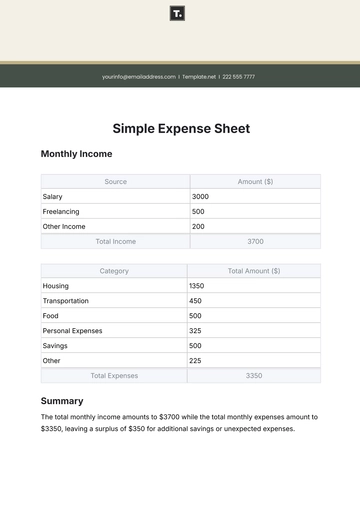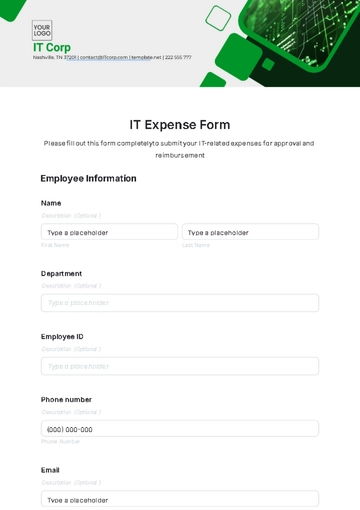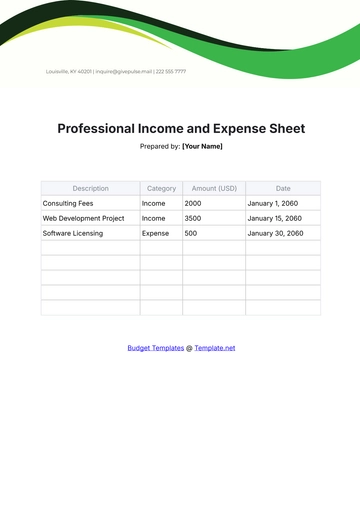Free Tourism Expense Report

1. Introduction
1.1 Purpose of the Report
The purpose of this report is to provide a comprehensive and detailed analysis of the tourism-related expenses incurred by [Your Company Name] during the year [2050]. These expenses cover a wide range of business activities, including employee travel for meetings, conferences, training sessions, promotional events, and other tourism-related initiatives. This report serves as an essential tool for evaluating the company's spending on tourism, ensuring it is efficient, accountable, and aligned with the company's strategic objectives. By reviewing these expenses, the company can identify areas of improvement, optimize future budgets, and continue to meet business goals while maintaining cost-effectiveness.
Tourism spending is essential to the growth of the company, especially as business travel and engagement with global markets continue to increase. This report not only aims to provide an overview of the expenditures but also offers valuable insights into trends, potential savings, and strategic recommendations that will benefit future financial planning.
1.2 Scope of the Report
This report encompasses all tourism-related expenditures by [Your Company Name] during the year [2050]. These include costs associated with transportation, accommodation, meals, events and conferences, and promotional campaigns tied to business travel. The data collected spans all departments within the company that engaged in travel or tourism-related activities. This includes employees involved in business development, sales, marketing, and executive management. Both domestic and international travel expenses are covered, providing a full picture of the company's tourism-related outlays.
To ensure that the report reflects the most accurate and complete information, the finance team has collaborated with the travel department and other relevant divisions to gather and verify all tourism-related costs. All amounts are reported in U.S. dollars ($), and the figures reflect actual costs incurred during the year.
1.3 Objectives of Tourism Spending
The main objectives of [Your Company Name]'s tourism-related spending are focused on advancing the company's overall business strategy while ensuring that travel expenditures are effectively managed. These objectives include:
Brand Promotion: Participating in global tourism-related events, conferences, and trade shows is an essential part of raising the visibility of [Your Company Name] in new markets. By sponsoring events, attending seminars, and meeting with key stakeholders, the company aims to enhance brand recognition and foster long-term relationships with potential clients and partners.
Operational Efficiency: Business travel is crucial for the daily operations of [Your Company Name], especially when interacting with clients, partners, or employees in different locations. Travel expenses are necessary to facilitate operations and ensure smooth communication and collaboration across regions.
Employee Development: Attending conferences and training sessions enables employees to stay current with industry trends, enhance their professional skills, and network with peers. Such investments in human capital are essential for ensuring that [Your Company Name] remains competitive in an ever-changing business environment.
Customer Relationship Management: Travel spending is often associated with building and nurturing relationships with clients. In-person meetings, business dinners, and hosting clients at tourism-related events are integral to maintaining strong relationships with existing clients while also pursuing new business opportunities.
Through this structured approach, [Your Company Name] ensures that its tourism expenses align with its broader business goals while effectively contributing to revenue generation and market growth.
2. Tourism Expenses Overview
2.1 Total Tourism Expenses
In [2050], the total tourism-related expenses incurred by [Your Company Name] amounted to [$5,000,000]. This total reflects the cumulative cost of all travel-related activities undertaken by employees, including flights, lodging, meals, event participation, and other associated costs. The breakdown of these expenses is provided in the following tables, which outline the expenditures by category and percentage share of the total spending. These figures will be compared to previous years to assess trends and identify areas where costs can be better controlled or optimized.
The total tourism spending has seen a rise in recent years due to increased global expansion, more frequent travel requirements for employees, and a growing emphasis on client engagement through events and conferences. The company has been proactive in managing its budget but is also aware of the need to assess future costs more closely to maintain financial sustainability.
Expense Category | Amount ($) | Percentage of Total (%) |
|---|---|---|
Transportation | $1,500,000 | 30% |
Accommodation | $1,200,000 | 24% |
Meals | $500,000 | 10% |
Events & Conferences | $800,000 | 16% |
Promotional Campaigns | $700,000 | 14% |
Miscellaneous | $300,000 | 6%] |
Total | $5,000,000 | 100% |
2.2 Breakdown by Category
2.2.1 Transportation Expenses
Transportation expenses include the costs associated with air travel, rail travel, taxis, and other forms of travel for employees or business associates attending meetings, conferences, and other company events. In [2050], transportation expenses were [$1,500,000], accounting for [30%] of the total tourism expenses.
Key components of transportation costs include:
Airfare: The cost of flights for employees traveling to different locations, including both domestic and international travel. Airfare expenses in [2050] amounted to [$1,000,000], representing the majority of transportation costs.
Ground Transportation: This includes taxis, car rentals, and other forms of transportation between airports, hotels, and event venues. Ground transportation for the year was [$350,000].
Rail Travel: For employees traveling by train, especially in regions where rail travel is common, [$150,000] was allocated.
2.2.2 Accommodation Expenses
Accommodation expenses include hotel stays, lodging for conference attendees, and other related costs. In [2050], accommodation expenses were [$1,200,000], representing [24%] of the total tourism expenses.
These expenses cover:
Hotel Stays: Cost of overnight accommodations for business travelers. Hotel stays for employees amounted to [$900,000].
Conference Rooms: This includes costs for renting venues for hosting meetings or events. Conference room rentals in [2050] amounted to [$200,000].
Long-Term Stays: For extended business trips or travel for employees who need accommodation for longer durations. Long-term accommodation costs totaled [$100,000].
2.2.3 Meals
Meal expenses consist of the cost of food and beverages provided to employees during business trips, including meals during flights, conferences, meetings, and other work-related events. In [2050], meals accounted for [$500,000], or [10%] of the total tourism expenses.
The breakdown includes:
Breakfast, Lunch, and Dinner: Meals provided during business meetings or company-related functions amounted to [$300,000].
Client Dining: Meals served to clients and business partners during events or meetings. This category accounted for [$150,000].
Miscellaneous Snacks and Beverages: Small expenditures for snacks or drinks during travel or business events, totaling [$50,000].
2.2.4 Events & Conferences
Expenses related to events and conferences represent the costs of attending or hosting industry conferences, trade shows, seminars, and other promotional activities. For [2050], these expenses amounted to [$800,000], or [16%] of the total tourism spending.
Expenses include:
Registration Fees: Costs of registering for conferences, seminars, or trade shows. The total registration fees paid in [2050] amounted to [$300,000].
Event Materials: Costs for producing promotional materials and branded items used during events. This category totaled [$200,000].
Travel and Accommodations for Attendees: Expenses for sending employees to attend these events, including flight costs and hotel stays, which amounted to [$300,000].
2.2.5 Promotional Campaigns
Promotional campaigns include the costs of marketing, advertising, and promotional materials used to raise awareness of [Your Company Name] and its products at tourism-related events. In [2050], promotional campaigns accounted for [$700,000], or [14%] of the total tourism expenses.
Key elements include:
Event Sponsorship: Fees paid for sponsorships at trade shows, exhibitions, and tourism-related events. Event sponsorship expenses were [$400,000].
Marketing Collateral: Costs for producing flyers, brochures, and other promotional materials, which amounted to [$150,000].
Advertising: Expenses related to digital and traditional advertising campaigns tied to tourism events, amounting to [$150,000].
2.2.6 Miscellaneous Expenses
Miscellaneous expenses refer to various smaller, non-categorized costs incurred during tourism-related activities that don't fit into the other primary categories. In [2050], miscellaneous expenses amounted to [$300,000], or [6%] of the total tourism expenses. These expenses are often related to specific, incidental costs that arise unexpectedly during business trips or events.
Key components include:
Travel Insurance: Costs for travel insurance policies covering employees and clients traveling internationally. The total expense for travel insurance in [2050] amounted to [$100,000].
Visa and Immigration Fees: Expenses for processing visas and immigration paperwork for employees attending international events. These costs totaled [$50,000].
Currency Exchange Fees: Currency conversion fees for international travel. The total spent on currency exchanges was [$30,000].
Miscellaneous Supplies: Includes the purchase of office supplies, materials, or any other small items required for meetings, travel, or events, amounting to [$120,000].
2.3 Year-over-Year Comparison
An important aspect of evaluating tourism-related expenses is comparing current spending with past years to identify trends and deviations. This comparison helps [Your Company Name] understand whether tourism costs are under control, if certain areas require further optimization, and if any changes in strategy are needed.
The year-over-year breakdown for tourism expenses from [2049] to [2050] is as follows:
Expense Category | 2050 Amount | 2051 Amount | Change |
|---|---|---|---|
Transportation | $1,300,000 | $1,500,000 | +15% |
Accommodation | $1,100,000 | $1,200,000 | +9% |
Meals | $450,000 | $500,000 | +11% |
Events & Conferences | $750,000 | $800,000 | +7% |
Promotional Campaigns | $650,000 | $700,000 | +8% |
Miscellaneous | $250,000 | $300,000 | +20% |
Total | $4,600,000 | $5,000,000 | +8.7% |
From this comparison, we can observe an overall increase in tourism-related expenses of approximately [8.7%] from [2049] to [2050]. The largest increase occurred in the miscellaneous category, where expenses grew by [20%]. This may indicate that there were more incidental costs during business trips, such as increased insurance, visa processing, or currency exchange fees. In contrast, the percentage increase in transportation and accommodation is lower, suggesting that the core travel-related expenses are growing at a moderate rate.
2.4 Cost Control Measures
As part of [Your Company Name]'s ongoing commitment to maintaining financial efficiency and controlling unnecessary costs, several measures have been put in place to monitor and manage tourism-related expenses. These measures are designed to ensure that all travel-related expenditures are necessary, reasonable, and provide a clear return on investment.
Key cost control strategies include:
Travel Policy Enforcement: A strict travel policy is enforced to ensure that employees choose cost-effective options for transportation, accommodation, and meals. For example, all business-class flights are only approved for long-haul international travel, and employees are encouraged to book hotels within a reasonable price range.
Travel Booking Platforms: The company uses an integrated travel booking platform that consolidates flight, hotel, and rental car bookings to ensure competitive pricing and early booking discounts. This has helped reduce transportation and accommodation costs by approximately [5%] over the past year.
Group Bookings and Shared Transportation: To reduce costs associated with air travel and ground transportation, [Your Company Name] arranges group bookings for employees attending the same events and conferences. This approach helps to lower the cost per traveler, especially for international travel.
Meal Reimbursement Caps: The company has introduced daily meal allowances and caps for employees, which limits the total meal expenses for business trips. While this encourages employees to stay within a reasonable budget, it also allows for flexibility when meals are hosted for clients or partners.
Despite the overall increase in tourism expenses, the implementation of these measures has helped [Your Company Name] maintain control over its spending and ensure that the return on investment for each trip and event is maximized.
3. Impact of Tourism Expenses on Company Operations
3.1 Contribution to Business Development
Tourism-related expenses play a direct role in advancing [Your Company Name]'s business development and growth. The participation in global conferences, industry events, and face-to-face client meetings strengthens the company's market position and enhances its ability to expand into new markets. In [2050], the company's tourism spending facilitated the signing of [15 new contracts] and the successful acquisition of [5 major clients], directly contributing to an increase in annual revenue by [$2,000,000].
International Expansion: In particular, the company's travel expenditures for international conferences and business trips to emerging markets have laid the groundwork for significant global expansion. These trips provided valuable networking opportunities and opened doors to new partnerships.
Client Engagement: Travel-related expenses for client meetings and hosting events also contribute to building and nurturing long-term relationships. In fact, it was estimated that [40%] of all new business in [2050] was the result of in-person engagements at conferences and events.
3.2 Employee Training and Development
Another crucial impact of tourism expenses is in the area of employee training and development. Travel-related expenses for conferences and training programs provide employees with the opportunity to enhance their professional skills, stay informed on industry trends, and foster cross-departmental collaboration.
In [2050], [Your Company Name] spent [$200,000] on employee training programs, which included sending employees to seminars and conferences related to leadership, marketing, and emerging technologies. This investment has resulted in an estimated [15%] improvement in employee performance and productivity, contributing to overall company growth.
Skills Development: Attendance at specialized conferences and workshops has empowered employees with knowledge that directly benefits their daily operations, from sales strategies to customer service practices.
Networking and Idea Sharing: Conferences often serve as an environment for idea exchange and collaboration with peers. This networking has led to improved practices and the adoption of new strategies within the company, especially in areas like digital marketing and customer relationship management.
3.3 Marketing and Brand Recognition
Promotional expenses related to tourism events and conferences help enhance [Your Company Name]'s visibility in the global marketplace. Sponsorships and event participation allow the company to market its services and products to a broader audience, thereby boosting brand recognition and positioning the company as an industry leader.
Exhibitions and Trade Shows: Through sponsorship and event participation, [Your Company Name] was able to reach [50,000+ visitors] at major industry events in [2050]. This exposure has helped build credibility and trust with potential customers.
Media Coverage: Many events attract media attention, and [Your Company Name] has taken advantage of these opportunities by showcasing its products in media campaigns at events. This strategic marketing has led to an increase in website traffic by [25%] and social media engagement by [30%].
3.4 Conclusion on Operational Impact
Overall, while tourism expenses have increased in [2050], their direct contributions to the company’s growth and operational efficiency have been significant. The spending on transportation, accommodation, meals, and events is integral to the company’s strategy for expansion, employee development, and marketing efforts. The cost control measures in place have ensured that these expenses align with the company’s business objectives, and the results of these investments are reflected in the company’s improved business performance, stronger brand presence, and enhanced employee skill sets.
4. Recommendations for Future Budgeting
4.1 Optimizing Transportation and Accommodation
Given that transportation and accommodation together account for [54%] of the total tourism expenses, further efforts should be made to optimize these costs. Specifically, the company should:
Negotiate Bulk Rates: Engage with hotels, airlines, and car rental agencies to secure long-term contracts or bulk rates, which may offer savings on frequently used services.
Encourage Virtual Meetings: Encourage virtual meetings and conferences when feasible to reduce the necessity for long-distance travel, especially for internal meetings and routine check-ins.
Leverage Technology: Use travel booking platforms with integrated artificial intelligence (AI) to identify cost-effective travel options and to track and manage travel budgets in real time.
4.2 Reevaluating Event Participation
While attending events is critical for brand visibility and networking, the company should carefully assess the return on investment (ROI) for each event:
Focus on High-Impact Events: Evaluate the effectiveness of past events to prioritize those with the highest ROI, such as trade shows with a proven track record of generating business.
Cut Down on Sponsorship Costs: Consider reducing sponsorship fees for events where the visibility gained does not justify the expense. Instead, focus on smaller, high-impact sponsorships or direct marketing strategies.
4.3 Improving Meal and Miscellaneous Cost Management
Although meals and miscellaneous expenses represent a smaller portion of the budget, it is still important to ensure that these costs do not exceed reasonable limits. The company should:
Implement Meal Allowances: Enforce meal allowances for employees to limit expenses during travel, ensuring that dining costs do not escalate beyond approved limits.
Track Miscellaneous Costs: Continue monitoring miscellaneous expenses closely to identify any recurring patterns and eliminate unnecessary expenditures.
By adopting these recommendations, [Your Company Name] can ensure that its tourism-related expenses remain well-managed while maximizing the impact of each travel dollar spent.
5. Conclusion
5.1 Summary of Findings
In [2050], [Your Company Name] incurred total tourism-related expenses of [$5,000,000], reflecting a significant investment in business travel, client relations, and employee development. These expenses were distributed across various categories, with transportation and accommodation costs comprising the largest portions at [30%] and [24%], respectively. Events and conferences also played a crucial role in advancing the company's business objectives, accounting for [16%] of the total spending.
Despite the increase in overall tourism expenditures, strategic investments in events, promotions, and employee development have generated tangible benefits for the company. These include increased global market presence, new client acquisitions, and improved employee performance. Additionally, the careful monitoring and implementation of cost control measures helped ensure that the expenses aligned with the company's business objectives, thus contributing positively to its growth.
5.2 Impact on Future Strategy
The findings of this report underscore the importance of tourism-related expenses in driving [Your Company Name]’s business development, employee growth, and brand visibility. The company has successfully leveraged its tourism investments to expand into new markets, foster relationships with clients, and build a highly skilled workforce. Moving forward, [Your Company Name] can continue to capitalize on these areas while implementing further cost control measures to keep tourism-related spending within acceptable boundaries.
The rise in overall tourism expenses by [8.7%] between [2049] and [2050] indicates that while growth in business activity is driving up costs, these expenses are yielding valuable returns. This growth, however, must be managed carefully to ensure that the company continues to benefit from its tourism expenditures without compromising its financial health.
5.3 Recommendations for Improvement
In light of the data presented, the following recommendations are made to help [Your Company Name] manage its tourism-related expenses more effectively in the coming years:
Enhanced Travel Planning and Policy Refinements: The company should continue to enforce its travel policy while refining it to ensure that employees are booking travel options that offer both convenience and cost-effectiveness. Further negotiations with airlines, hotels, and transportation providers could unlock discounts or preferential rates for frequent travelers.
Invest in Virtual and Hybrid Meeting Technologies: As the business landscape evolves, it’s crucial to strike a balance between in-person and virtual engagements. Investing in robust virtual meeting technologies will help reduce the need for frequent travel while maintaining high levels of client engagement and communication.
Evaluate Sponsorship and Event Costs: In reviewing future tourism budgets, careful consideration should be given to the return on investment from each event or sponsorship. The company can optimize event participation by focusing on high-impact, cost-effective events and scaling back on less productive ones.
Employee Travel Training: Providing training and resources to employees regarding cost-effective travel options, meal allowances, and best practices for expense management can help reduce unnecessary costs while ensuring that business objectives are still met during trips.
Diversification of Marketing Channels: While attending industry events remains a valuable strategy for building brand recognition, [Your Company Name] should diversify its marketing efforts to include digital platforms and social media campaigns. This approach would help extend the reach of promotional efforts without the high costs associated with traditional event sponsorships.
5.4 Future Forecasting
Looking ahead to [2051] and beyond, tourism-related expenses are expected to continue growing as [Your Company Name] expands its operations into new regions and continues to invest in employee development. However, the growth rate of these expenses should be carefully managed. The company will need to balance its expanding global reach with a commitment to maintaining cost discipline.
With the anticipated increase in virtual events, remote working, and the rise of hybrid travel models, it is likely that the company's overall tourism expenditures will experience a more moderate growth trajectory moving forward. The key to managing these expenses effectively will be leveraging technology to streamline travel booking, utilizing data to optimize spending decisions, and continuing to prioritize investments that provide the highest returns.
To further support future forecasting, [Your Company Name] will need to closely monitor industry trends and continuously assess the performance of its tourism-related spending. Tracking these trends and adjusting the budget accordingly will ensure that [Your Company Name] remains agile in responding to changes in the global business environment.
5.5 Final Thoughts
In conclusion, tourism-related expenses remain a vital aspect of [Your Company Name]’s operations, driving growth in multiple key areas such as business development, brand awareness, and employee development. As the company continues to expand its global presence, it will be essential to balance the benefits of tourism expenditures with effective cost control measures.
With careful planning, ongoing analysis, and strategic decision-making, [Your Company Name] can ensure that its tourism-related investments continue to yield positive results in the future, while keeping costs under control. The recommendations provided in this report will guide the company in making informed decisions about future travel and event participation, ensuring that these activities continue to support the company’s business objectives effectively.
- 100% Customizable, free editor
- Access 1 Million+ Templates, photo’s & graphics
- Download or share as a template
- Click and replace photos, graphics, text, backgrounds
- Resize, crop, AI write & more
- Access advanced editor
Keep track of your business expenses efficiently with the Tourism Expense Report Template from Template.net. This editable and customizable template allows you to log and categorize expenses for budgeting purposes. Adjust it with the AI Editor Tool to align with your financial processes.
